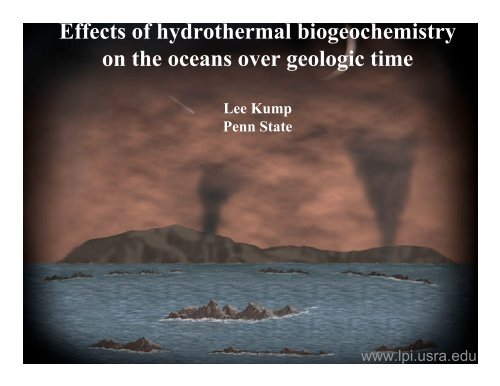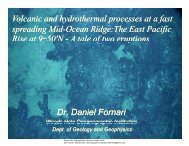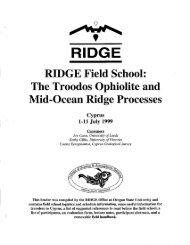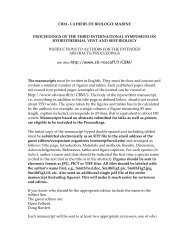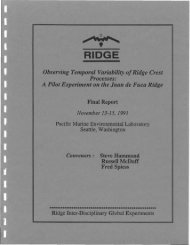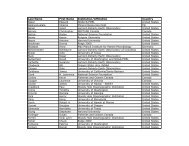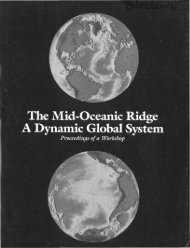Effects of hydrothermal biogeochemistry on the oceans over ...
Effects of hydrothermal biogeochemistry on the oceans over ...
Effects of hydrothermal biogeochemistry on the oceans over ...
You also want an ePaper? Increase the reach of your titles
YUMPU automatically turns print PDFs into web optimized ePapers that Google loves.
<str<strong>on</strong>g>Effects</str<strong>on</strong>g> <str<strong>on</strong>g>of</str<strong>on</strong>g> <str<strong>on</strong>g>hydro<strong>the</strong>rmal</str<strong>on</strong>g> <str<strong>on</strong>g>biogeochemistry</str<strong>on</strong>g><br />
<strong>on</strong> <strong>the</strong> <strong>oceans</strong> <strong>over</strong> geologic time<br />
Lee Kump<br />
Penn State<br />
www.lpi.usra.edu
• Mantle-dominated Archean Ocean<br />
• Hydro<strong>the</strong>rmal fluids in <strong>the</strong> absence <str<strong>on</strong>g>of</str<strong>on</strong>g> sulfate (redox, no<br />
anhydrite)<br />
• Submarine volcanism and <strong>the</strong> rise <str<strong>on</strong>g>of</str<strong>on</strong>g> atmospheric<br />
oxygen<br />
• Phanerozoic major-element chemistry and vent fluids<br />
• Wils<strong>on</strong> cycles <str<strong>on</strong>g>of</str<strong>on</strong>g> seafloor producti<strong>on</strong>, Mg/Ca and CO 2<br />
• Fluid inclusi<strong>on</strong>s and modeling<br />
• Problems<br />
• C<strong>on</strong>clusi<strong>on</strong>s c<strong>on</strong>cerning role <str<strong>on</strong>g>of</str<strong>on</strong>g> <str<strong>on</strong>g>hydro<strong>the</strong>rmal</str<strong>on</strong>g> geochemistry<br />
in evoluti<strong>on</strong> <str<strong>on</strong>g>of</str<strong>on</strong>g> ocean chemistry<br />
www.lpi.usra.edu
HIGH Fe, H 2 , H 2 S<br />
LOW 87 Sr/ 86 Sr<br />
Stanley and Hardie, 1999
Shields & Veizer (2002)
Shields & Veizer (2002)
Knoll and Holland (1995)
Hust<strong>on</strong> & Logan (2004)
Kump and Seyfried (2005)
Cooling path for vent fluid derived from<br />
sulfate-bearing seawater<br />
Kump and Seyfried (2005)
Cooling path for vent fluid derived from<br />
sulfate-free seawater<br />
Kump and Seyfried (2005)
Why are ridges today near <strong>the</strong><br />
critical curve for seawater?<br />
de Wit, 1998
Effect <str<strong>on</strong>g>of</str<strong>on</strong>g> pressure and temperature <strong>on</strong> dissolved Fe in 3.2% NaCl<br />
(seawater) coexisting with basalt and its alterati<strong>on</strong> products<br />
14<br />
12<br />
Modern Seafloor<br />
410°C<br />
Modern Subseaflor Reacti<strong>on</strong><br />
Z<strong>on</strong>es<br />
778<br />
667<br />
Fe, mmolal<br />
10<br />
8<br />
6<br />
4<br />
380<br />
400<br />
390<br />
556<br />
444<br />
333<br />
222<br />
Fe, ppm<br />
2<br />
0<br />
350 360 370<br />
111<br />
0<br />
150 200 250 300 350 400 450 500 550<br />
Terminati<strong>on</strong> <str<strong>on</strong>g>of</str<strong>on</strong>g> iso<strong>the</strong>rms at low pressure<br />
defines <strong>the</strong> two-phase boundary <str<strong>on</strong>g>of</str<strong>on</strong>g> seawater<br />
Pressure, bars<br />
Data from: Seyfried (1987), Seyfried and<br />
Janecky (1985); Rosenbauer and Bisch<str<strong>on</strong>g>of</str<strong>on</strong>g>f<br />
(1983)<br />
Kump and Seyfried (2005)
Kump and Seyfried (2005)
Dales Gorge, Paleoproterozoic
Why did atmospheric O 2 rise<br />
at ~2.4 Ga?<br />
• This is when cyanobacteria<br />
invented oxygenic<br />
photosyn<strong>the</strong>sis; or<br />
• Cyanobacteria evolved<br />
oxygenic photosyn<strong>the</strong>sis ≥<br />
2.7 Ga, but O 2 sinks<br />
exceeded sources until 2.4<br />
Ga
Rise <str<strong>on</strong>g>of</str<strong>on</strong>g> oxygen occurs when sources exceed sinks<br />
org C, pyr S<br />
burial<br />
CO 2 + H 2 O<br />
CH 2 O + O 2<br />
Atmospheric O 2<br />
org C, pyr S<br />
wea<strong>the</strong>ring<br />
oxidati<strong>on</strong> <str<strong>on</strong>g>of</str<strong>on</strong>g><br />
volcanic fluids<br />
Holland’s (2002) “f” value: reducing power <str<strong>on</strong>g>of</str<strong>on</strong>g> volcanic gas or<br />
<str<strong>on</strong>g>hydro<strong>the</strong>rmal</str<strong>on</strong>g> fluid relative to biospheric demand: f > 1 allows<br />
H 2 to accumulate in atmosphere (i.e., no O 2 )
Phanerozoic Trends
Lowenstein et al. 2003 (Geology)
Published by AAAS<br />
T. K. Lowenstein et al., Science 294, 1086 -1088 (2001)
Fantle (unpub)
Hydro<strong>the</strong>rmal uptake <str<strong>on</strong>g>of</str<strong>on</strong>g> Mg, release <str<strong>on</strong>g>of</str<strong>on</strong>g> Ca<br />
∝ (spreading rate, [Mg 2+ ] )
Gaffin sea-level inversi<strong>on</strong>, no feedback<br />
T. K. Lowenstein et al., Science 294, 1086 -1088 (2001)<br />
Published by AAAS
Growing c<strong>on</strong>sensus:<br />
variati<strong>on</strong>s in seafloor spreading<br />
rate c<strong>on</strong>trol:<br />
CO 2 fluctuati<strong>on</strong>s<br />
climate variati<strong>on</strong>s<br />
(hothouse/greenhouse)<br />
seawater chemistry<br />
carb<strong>on</strong>ate mineralogy
But problems!<br />
alkalinity balance<br />
seafloor producti<strong>on</strong> rates haven’t varied<br />
significantly through time! (?)<br />
or if <strong>the</strong>y have, <strong>the</strong>y’ve INCREASED <strong>over</strong><br />
last 30-40 milli<strong>on</strong> years
Gaffin sea-level inversi<strong>on</strong>, no feedback<br />
Gaffin sea-level inversi<strong>on</strong>, feedback<br />
T. K. Lowenstein et al., Science 294, 1086 -1088 (2001)<br />
Published by AAAS
Rowley (2002)
Implicati<strong>on</strong>s<br />
No CO 2 driver<br />
No seafloor chemistry driver<br />
No sea-level driver<br />
Expected result: global rate <str<strong>on</strong>g>of</str<strong>on</strong>g> seafloor<br />
producti<strong>on</strong> ultimately tied to mean rate <str<strong>on</strong>g>of</str<strong>on</strong>g><br />
heat producti<strong>on</strong> in mantle (varies slowly in<br />
time)
But wait!<br />
Demicco (2004)<br />
spreading rates today vary from 7.3 to 180<br />
mm/yr<br />
Kominz (1984) showed that spreading rates for<br />
preserved seafloor clearly varied through time<br />
sublithospheric flows n<strong>on</strong>-steady<br />
ridge jumps, abrupt changes in plate moti<strong>on</strong>s,<br />
subducti<strong>on</strong> <str<strong>on</strong>g>of</str<strong>on</strong>g> ridges => steady state model<br />
unlikely (?)
Demicco (2004)
Cogne and Humler, 2006
new<br />
old<br />
Miller et al. (2006)
Anoxia, pyrite, dolomite<br />
Oxic<br />
Anoxia, pyrite, dolomite<br />
Miller et al. (2006)
C<strong>on</strong>clusi<strong>on</strong>s<br />
• Vent fluids today, and associated biological<br />
communities, may not be good analogue for those<br />
<str<strong>on</strong>g>of</str<strong>on</strong>g> <strong>the</strong> distant geologic past, especially if sulfate<br />
c<strong>on</strong>tent <str<strong>on</strong>g>of</str<strong>on</strong>g> seawater has varied.<br />
• Archean <str<strong>on</strong>g>hydro<strong>the</strong>rmal</str<strong>on</strong>g> systems were Fe- and H 2 -<br />
rich and unclogged.<br />
• Vent fluids played an important role in<br />
c<strong>on</strong>trolling seawater chemistry early in Earth<br />
history; role in <strong>the</strong> more recent geologic past<br />
unclear.<br />
www.dfo-mpo.gc.ca


